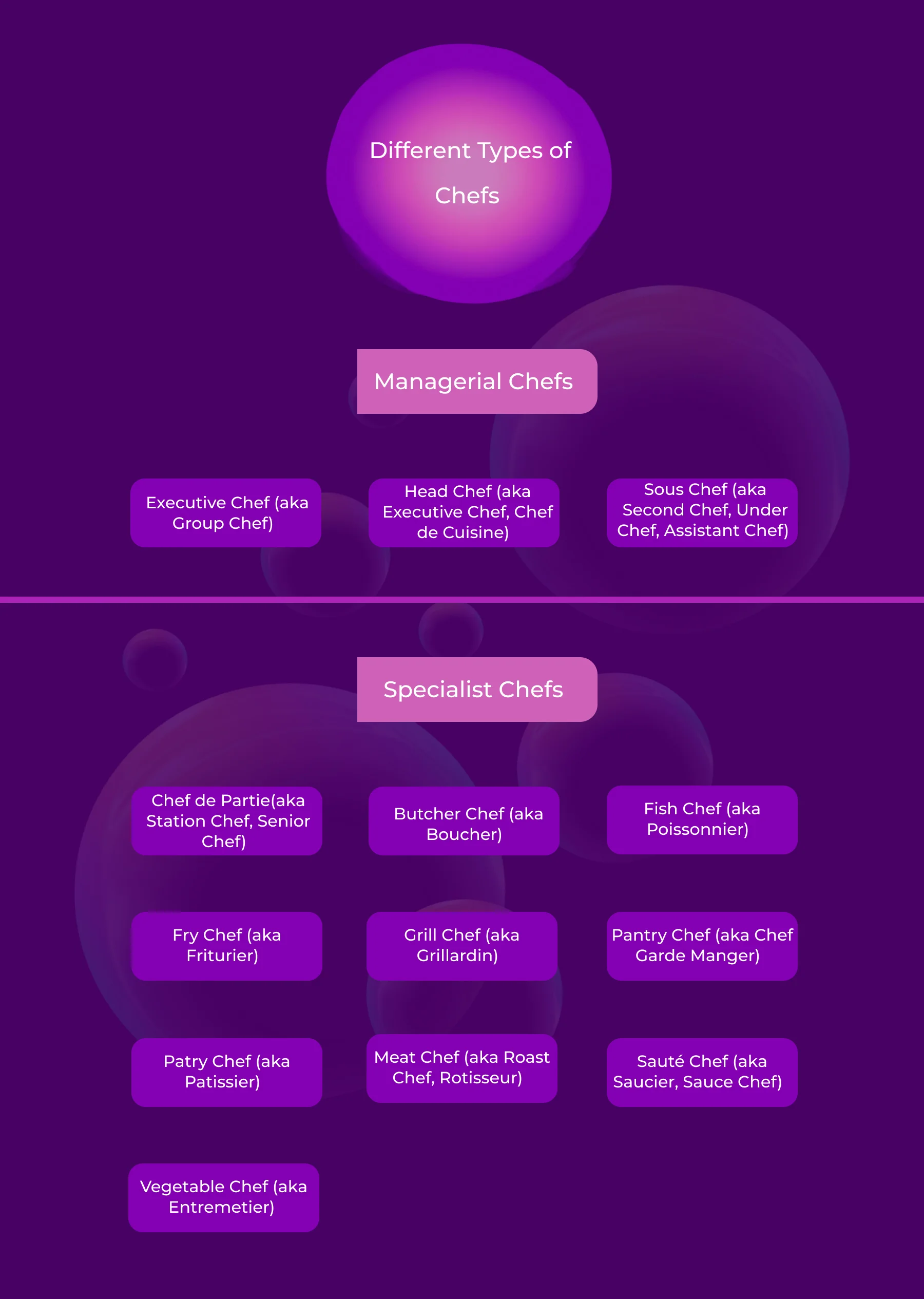14 Types of Chefs You Need to Know
Every great restaurant has a team of chefs working together to create an amazing meal. Each chef in the kitchen has their own responsibilities to ensure each guest has a successful experience, from designing recipes to testing sauces. Hierarchy in the kitchen ensures organization and high-quality meals while chefs work together.
You can find a list and description of almost all chefs in a professional kitchen below.

The executive chef is the highest position in the chef hierarchy, and it takes years of hard work and expertise to become an executive. An executive chef is also known as a head chef, as most kitchens employ the same person in both positions. As the name suggests, the executive chef oversees all kitchen staff and operations.
The executive chef is not responsible for preparing or cooking any dishes. Rather, they ensure that every dish is flawless and up to standard before reaching customers.
An executive chef is therefore responsible for guiding the sous chef, or other chefs involved in cooking and tasting food, before they are served to customers.
2. Sous Chef
A sous chef is another type of chef that you may be familiar with. So, what exactly is a sous chef? This type of chef works closely with the executive chef. They are responsible for supervising the chefs and keeping the kitchen on time. They are sometimes more involved in decision-making as they ensure the chefs work together and accomplish their responsibilities.
In addition to a culinary degree, a sous chef should be an excellent leader and team manager. They are frequently entrusted with training new chefs and helping the head chef in implementing the restaurant's concept.
3. Chef de Partie
The chef de partie is the kitchen's next important role. This type of chef oversees station management and specializes in a specific item on the menu. They often start as line cooks before being promoted to chef de partie.
This type of chef will collaborate with the executive chef to create menus and help prepare key ingredients for the meal. A chef de partie reports to both the executive chef and the sous chef after a successful day at the restaurant. This type of chef's job involves graduation from a culinary school and substantial kitchen experience.
4. Pastry Chef
Pastry Chefs are another type of specialized chef. A Pastry Chef is someone who specializes in baking and creating sweets. Pastry chefs create everything from candy to lavish cakes and devise new menu items.
Pastry Chefs must get specialized training in the Pastry Arts, which differs from the Culinary Arts. Most culinary institutes provide Culinary Arts and Pastry Arts degrees and diplomas.
Pastry Chefs and Executive Chefs sometimes work on the same level, particularly in restaurants where dessert is as important as the main course. They may occasionally work together to create recipes that blend sweet and savory ingredients. If you enjoy baking, pastry, and desserts, the role of Pastry Chef may be a wonderful fit for you.
5. Saucier
Another type of chef in a kitchen is the saucier. This type of chef ensures high-quality sauces, soups, and stews in a restaurant. They are most hired at fine-dining French restaurants.
The saucier chef may also collaborate with several chefs to create flavors that match other dishes on the menu. The saucier, like other chefs, reports to the executive chef and the sous chef. To begin a career as a saucier chef, a combination of culinary school and kitchen experience will ensure a competent position in the kitchen.
6. Fish Chef
The fish chef is one type of chef who may work in the kitchen. This chef is in charge of selecting, preparing, and cooking sustainable seafood for the menu. From sushi to exquisite halibut, fish experts ensure that each dish has exceptional flavor and complimentary sides. They might also develop partnerships with local suppliers to source the best-caught fish for the restaurant.
To obtain this role, most fish chefs must complete a culinary degree and have restaurant experience. They also report to the executive chef and sous chef while collaborating with a variety of cooks in the kitchen.
7. Vegetable Chef
Vegetable chefs play a vital part in any professional kitchen. This type of chef is in charge of preparing and cooking all veggies and starches for each meal. From tossing salads with spicy dressings to slicing vegetables for a side dish, they make sure that each vegetable compliments the flavors of the dish. They may also prepare vegetable soups, toppers, or stand-alone vegetable dishes for a whole meal.
Most vegetable chefs go to culinary school, especially if they want to specialize in vegetarian and vegan food. Other vegetable chefs consider the experience in a professional kitchen to be key to their education.

8. Meat Chef
The meat chef, often known as the rotisserie or roast chef, is another type of chef in a restaurant kitchen. These chefs roast, braise, or broil different kinds of meat to bring out the executive chef's idea. Meat chefs may also purchase meat from local vendors or stores to stock the kitchen.
These chefs might pursue a degree in Culinary Arts or choose to further develop their skills in professional kitchens. They report to the executive chef and the sous chef to ensure that the meat meets the restaurant's standards.
9. Pantry Chef
The pantry chef is in charge of stocking and preparing cold foods. They ensure that each ingredient is fresh and maintains quality for the restaurant's customers. These chefs may also create culinary centerpieces or displays for the buffet table.
Each kitchen normally has one pantry chef, but bigger businesses may have two. They collaborate with other chefs to incorporate cold foods, but mostly report to the executive and sous chefs.
10. Fry and Grill Chef
The fry chef operates the fryer in the kitchen. For the menu's fried items, they may bread or batter the ingredients before frying them. These chefs also deep clean the fryer to ensure that the station is clean and efficient.
Although a fry chef may attend culinary school, most of them have substantial experience working with a fryer at a restaurant. In addition to reporting to the executive and sous chefs, they may work with the vegetable chef or butcher chef to make fried menu items.
The grill chef is another popular type of chef in professional kitchens. This job cooks meat, fish, and vegetables for specific menu items. A restaurant typically has one grill cook, but larger establishments may have two.
In addition to reporting to the executive and sous chefs, the grill chef often collaborates with the vegetable chef and butcher chef to consult and prepare meals for the restaurant.
11. Butcher Chef
The butcher chef is another type of chef who works in professional kitchens. These chefs are most common in larger restaurants, where they help plan and prepare different types of meats. They are in charge of sourcing meat for the kitchen, which they do through local meat suppliers or merchants.
A butcher chef's major responsibility is to prepare meat for each station, typically for the grill chef and meat chef. They source and slice the right meats and keep track of the kitchen's meat inventory. Although not every kitchen has a butcher chef, they are an excellent resource for the executive and sous chef.
12. Chef Consultant
Chef Consultants, as an alternative to cooking in a professional kitchen, are hired to help restaurants and businesses improve their food operations. A restaurant may hire a Chef Consultant to assist with creating a new menu, increasing profits and/or efficiency, or training employees.
In some cases, a Chef Consultant is called in to offer second opinions on why a kitchen is experiencing problems or failing to stay afloat. Chef Consultants must be skilled culinarians with expertise in Hospitality and Restaurant Operations Management.
Chef consultants are constantly on the move and must have an entrepreneurial spirit. If you enjoy fast-paced, challenging work and don't mind being “in the thick of it," you could be a good fit for a career in chef consulting.
13. Personal Chef
Personal chefs do not work for others in professional kitchens. It is more common for them to work in private locations and to cook for a variety of clients. Personal chefs are entrepreneurs.
Personal chefs usually serve food to multiple families. They can visit any of their client's houses once or twice a week to make food using the client's kitchen space, package and store the food, and provide reheating instructions. Alternatively, they can cook food at a commissary kitchen and deliver packed items to consumers, along with instructions.
14. Private Chef
Private Chefs are like Personal Chefs but work for a specific family. They often travel with their families from their primary residence to a vacation property, or even aboard yachts, private aircraft, and so on.
As a personal or private chef, you will be your own boss, thus you must have the necessary business skills to succeed. If you enjoy organizing, cooking, providing customer service, and having control over your own schedule, these alternative employment choices may be right for you.
KEY TAKEAWAYS!

